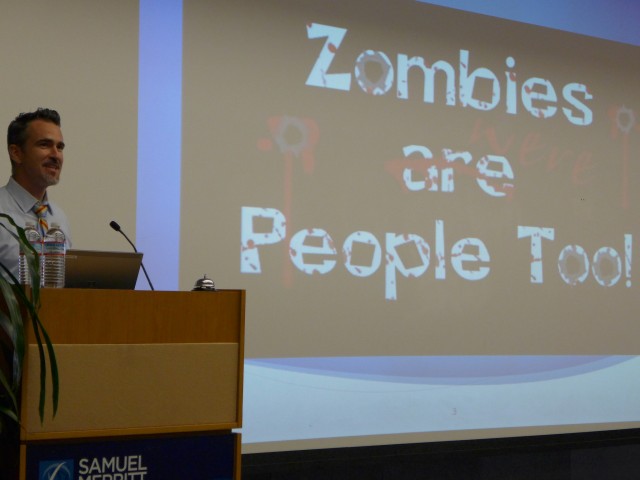Gorman translated data from scientific papers dealing with the alive -- and applied it to the undead.
“If it’s a slow zombie, you want to look for a gait speed for yourself of between 1.63 meters per second to 4.47 meters per second, and that should successfully get you away from zombies,” she said.
That’s between about 3.5 to 10 miles per hour. By comparison, the average person’s walking speed is just over three miles per hour. But 10 miles per hour would mean running at six minute miles. Good luck if you encounter a fast zombie.
Counseling is Key in Event of Zombie Apocalypse
Craig Elliott, assistant vice president of enrollment and student services, tackled the emotional side of a zombie apocalypse.
“How do you mourn that (a) zombie that represents your family member is not truly your daughter, wife, husband or son?”
Elliot said it’s important to remember that zombies were people too -- and that it’s okay to grieve.
“In those unexpected times, we have a greater sense of vulnerability and heightened anxiety about it," Elliott said. "We’ve got to deal with what that means for us and who we are and how we’re feeling.”
Elliott recommends counseling to help overcome the grief associated with a loved one turning into a zombie.
In a video, basic sciences professor Barb Puder held up a model of a brain and explained exactly what’s going on in a zombie’s head. The cortex, the front part of the brain where feeling and thinking goes on, is no longer functional in zombies, she said. Instead, when looking at zombie brains, scientists look at the brain stem.
“That is activated in the zombie," Puder said. "That’s the part that controls ... internal organs, allows for movement, but not really personality and speech and behaviors. And this is the part of the brain that we need to destroy to get rid of our zombie population."
Crowbar best weapon
The big question is how. How do we rid ourselves of the zombie population?
Puder had specific advice on the best weapons to kill a zombie. She suggested aiming for the eyes or lower— anything higher won’t damage the brain stem. Longer weapons are more effective. Short screwdrivers, for example, might not reach far enough back.
Her weapon of choice? A crow bar.
Dr. Drew Smith, who runs the university’s Motion Analysis Research Center, reviewed a case where a young woman appeared to be having trouble walking. When researchers played music in the lab, the patient’s gait changed from an ungainly lurching motion to something surprisingly like Michael Jackson’s Thriller dance.
Occupational therapy professor Gordon Giles took issue with calling these afflicted people “zombies.” He reminded students never to call patients by their diagnosis.
“We don’t stay ‘the schizophrenic,’” he said. “We don’t stay ‘the femoral fracture in the end bed.’ So I really think that we need to use person-first language. And I would really suggest that."
"Except of course, they’re not actually people.”
Giles instead urged student to use the term “animated dead.”
“Like many people who have severe cognitive impairments, the animated dead do not follow directions," Giles said, "but they will follow you. Rapidly.”
“I just want to say maintaining a therapeutic relationship is really important for us as occupational therapists," Giles said. "But it’s difficult with the animated dead. So I want you all to remember that they do love us for what’s on the inside.”
Cue collective groan. Or, make that a collective zombie moan. Aarrrghhhh.
